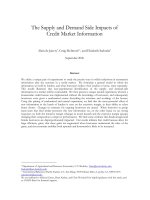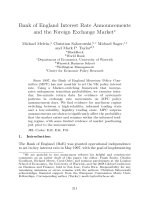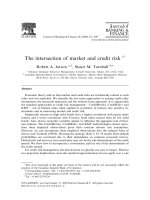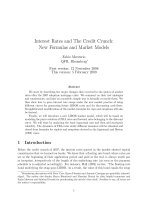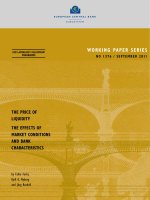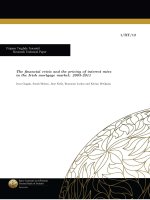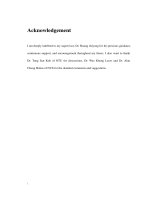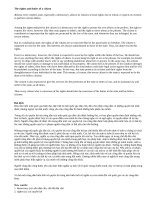Reading 9 the firm and market structures answers
Bạn đang xem bản rút gọn của tài liệu. Xem và tải ngay bản đầy đủ của tài liệu tại đây (856.67 KB, 55 trang )
Question #1 of 118
Question ID: 1377495
If an industry features differentiated products but has low barriers to entry, in the long run
the firms in the industry will experience:
A) economic losses.
B) sustainable economic profits.
C) zero economic profits.
Explanation
An industry with low barriers to entry will produce zero economic profits in the long run.
(Study Session 3, Module 9.2, LOS 9.b)
Question #2 of 118
Question ID: 1377474
The short-run supply curve to a firm operating under perfect competition is most accurately
described as the segment of the:
A) average total cost (ATC) curve above the average variable cost (AVC) curve.
B) marginal cost (MC) curve above the average variable cost (AVC) curve.
C) marginal cost (MC) curve below the average total cost (ATC) curve.
Explanation
The short-run supply curve for a firm under perfect competition is the segment of its MC
curve above the AVC curve.
(Study Session 3, Module 9.1, LOS 9.c)
Question #3 of 118
Question ID: 1377501
The kinked demand model assumes that at prices above the current price, the demand
curve becomes:
A) more elastic because competitors will not increase their prices.
B) more elastic because competitors will increase their prices.
C) less elastic because competitors will not increase their prices.
Explanation
The kinked demand model of oligopoly behavior assumes that a firm's competitors will not
match a price increase, but will match the price of a competitor that offers a lower price.
The result is a demand curve that is more elastic above the current price, but less elastic
below it.
(Study Session 3, Module 9.3, LOS 9.d)
Question #4 of 118
Question ID: 1377509
When a regulatory agency requires a monopolist to use average cost pricing, the intent is to
produce the quantity where the:
A) the market demand curve intersects the average total cost curve.
B) average total cost curve intersects the marginal revenue curve.
C) marginal revenue curve intersects the marginal cost curve.
Explanation
When a regulatory agency requires a monopolist to use average cost pricing, the intent is
to price the product where the average total cost curve intersects the market demand
curve. There are problems in using this method, e.g., determining exactly what the
average total cost really is.
(Study Session 3, Module 9.4, LOS 9.b)
Question #5 of 118
Question ID: 1377460
A perfectly competitive firm will continue to increase output so long as which of the
following conditions exists?
A) Marginal revenue is positive.
B) Marginal revenue is greater than price.
C) Market price is greater than marginal cost.
Explanation
A perfectly competitive firm will tend to expand its output so long as the market price is
greater than marginal cost since price and marginal revenue are equal. In the short term
and long term, profit is maximized when marginal cost and marginal revenue are equal
(i.e., MC = MR).
(Study Session 3, Module 9.1, LOS 9.b)
Question #6 of 118
Question ID: 1377508
Which of the following describes the regulatory practice of setting prices at a level where the
monopoly firm's average total cost curve intersects the demand curve?
A) Average cost pricing.
B) Marginal cost pricing.
C) Cost-of-service pricing.
Explanation
Under average cost pricing, regulators attempt to force monopolies to reduce prices to
where a firm's average total cost curve intersects the market demand curve. This will
increase output and decrease price, increase allocative efficiency, and ensure zero
economic profit.
(Study Session 3, Module 9.4, LOS 9.b)
Question #7 of 118
Question ID: 1377439
Monopolistic competition differs from pure monopoly in that:
A) monopolistic competitors are price takers and monopolists are not.
B) monopolistic competitors have low barriers to entry and monopolists do not.
C) monopolists maximize profits and monopolistic competitors do not.
Explanation
Another name for monopolistic competition is a competitive price searcher market.
Monopolistic competition refers to a large number of independent sellers, each produces
a differentiated product, each market has a low barrier to entry, and each producer faces
a downward sloping demand curve.
(Study Session 3, Module 9.1, LOS 9.a)
Question #8 of 118
Question ID: 1377448
Which of the following situations is least likely to lead to high barriers to entry and
monopoly supply?
A) Economies of scale are present.
B) Governmental licensing and regulations are present.
C) Natural resources are spread among many firms.
Explanation
All cases except wide distribution of a natural resource facilitate a monopoly. If natural
resource ownership is concentrated in one firm a monopoly would result.
(Study Session 3, Module 9.1, LOS 9.a)
Question #9 of 118
Question ID: 1377472
The short-run supply curve for a purely competitive market:
A) is a horizontal line.
B) slopes downward to the right.
C) slopes upward to the right.
Explanation
The short-run supply curve for a purely competitive market slopes upward to the right.
This reflects the fact that firms in the industry will produce more when the price rises.
(Study Session 3, Module 9.1, LOS 9.c)
Question #10 of 118
An oligopoly is least likely characterized by:
A) barriers to entry.
B) economies of scale.
C) a large number of sellers.
Question ID: 1377440
Explanation
Oligopolies consist of a small number of sellers. They tend to be characterized by barriers
to entry such as significant economies of scale.
(Study Session 3, Module 9.1, LOS 9.a)
Question #11 of 118
Question ID: 1377525
The practice of charging different consumers different prices for the same product or
service is called:
A) price discrimination.
B) variable pricing.
C) price searching.
Explanation
The practice of charging different consumers different prices for the same product or
service is called price discrimination.
(Study Session 3, Module 9.4, LOS 9.d)
Question #12 of 118
Question ID: 1377517
A monopolist will expand production until:
A) MR = MC and the price of the product will be determined by the MR curve.
B) MR = MC and the price of the product will be determined by the demand curve.
C) P = MC and the price of the product will be determined by the MC curve.
Explanation
A monopolist will expand production until MR = MC. The demand curve lies above the
intersection of the MR and MC curve and the price charged is the price on the demand
curve for the output where MR = MC.
(Study Session 3, Module 9.4, LOS 9.d)
Question #13 of 118
Question ID: 1377493
When firms are earning positive economic profits in an industry characterized as
monopolistic competition, it is most likely that:
A) these economic profits can be sustained in the long run.
B) new competitors will enter the industry.
C) price takers will lose market share to price searchers.
Explanation
Monopolistic competition describes a price searcher market with low barriers to entry.
Because new competitors can enter the industry easily, economic profits cannot be
sustained in the long run.
(Study Session 3, Module 9.2, LOS 9.b)
Question #14 of 118
Question ID: 1377465
A competitive firm will tend to expand its output as long as:
A) its marginal revenue is greater than the market price.
B) its marginal revenue is positive.
C) the market price is greater than the marginal cost.
Explanation
A competitive firm faces a flat demand curve. This means the price is constant and the
marginal revenue line is flat. A firm will continue to produce as long as MR > MC, so the
competitive firm will produce as long as P > MC. It will stop when MC = MR = P.
(Study Session 3, Module 9.1, LOS 9.b)
Question #15 of 118
Question ID: 1377463
A profit maximizing firm will expand output as long as marginal revenue is:
A) greater than marginal cost.
B) less than marginal cost.
C) greater than average fixed cost.
Explanation
A purely competitive firm will tend to expand its output so long as the market price
(marginal revenue) is greater than marginal cost. In the short term and long term, profit is
maximized when P = MC.
(Study Session 3, Module 9.1, LOS 9.b)
Question #16 of 118
Question ID: 1377507
Which of the following is least likely to be considered a reason why regulation of monopolies
is not effective?
A) Regulation shifts industry demand and increases prices.
B) Regulation reduces the incentive for firms to reduce costs.
C) Regulators do not know the firm’s cost structure.
Explanation
Regulation is not associated with a shift in industry demand.
(Study Session 3, Module 9.4, LOS 9.b)
Question #17 of 118
Question ID: 1377432
The demand curves faced by monopolistic competitors is:
A) elastic due to the availability of many close substitutes.
B) inelastic due to the availability of many complementary goods.
C) not sensitive to price due to absence of close substitutes.
Explanation
The demand for products from monopolistic competitors is elastic due to the availability
of many close substitutes. If a firm increases its product price, it will lose customers to
firms selling substitute products.
(Study Session 3, Module 9.1, LOS 9.a)
Question #18 of 118
Question ID: 1377515
Which of the following statements about monopolies is most accurate?
A) Monopolists charge the highest possible price.
B)
C)
A monopoly structure is characterized by a well-defined product for which there
are no good complements.
A monopolist's optimal production quantity is at the point where marginal
revenue equals marginal cost.
Explanation
All firms maximize profits where MR = MC. Because of a downward-sloping demand curve
and high barriers to entry, monopolists can charge a price higher than MC. Like other price
searchers, monopolists take price from the demand curve (at the quantity where MR =
MC).
Both remaining statements are false. A monopoly structure is characterized by a welldefined product for which there are no good substitutes. Monopolists want to maximize
profits, not price.
(Study Session 3, Module 9.4, LOS 9.b)
Question #19 of 118
Question ID: 1377446
Natural monopolies exist because they can produce at lower costs with greater output,
which means there are economies of scale. Which of the following industries is typically a
natural monopoly?
A) Utilities.
B) Oil.
C) Technology.
Explanation
With a natural monopoly average costs of production will be lowest when a single large
firm produces the entire output demanded such as a utility.
(Study Session 3, Module 9.1, LOS 9.a)
Question #20 of 118
Question ID: 1377533
In which of the following market structures is price least likely to be greater than marginal
cost?
A) Monopolistic competition.
B) Monopoly.
C) Perfect competition.
Explanation
In a perfect competition price is equal to marginal cost and marginal revenue when a firm
is producing at its profit maximizing quantity. In monopolies and markets characterized by
monopolistic competition, price is greater than marginal cost and marginal revenue when
producing at the profit maximizing quantity.
(Study Session 3, Module 9.4, LOS 9.f)
Question #21 of 118
Question ID: 1377476
The short-run supply curve for a firm in a perfectly competitive market is equal to the firm's:
A) ATC curve.
B) AVC curve.
C) MC curve.
Explanation
The short-run supply curve for a firm in a perfectly competitive market is equal to the
firm's MC curve. A price taker will maximize profits when it produces the output level
where P = MC. As price rises, its point of intersection with the MC curve indicates optimal
production.
(Study Session 3, Module 9.1, LOS 9.c)
Question #22 of 118
Question ID: 1377500
Assume that the market for paper supplies and the market for toothpicks have the following
characteristics:
The Market for Paper Supplies is comprised of:
A large number of independent sellers
Differentiated products
Low barriers to entry/exit
The Market for Toothpicks is comprised of:
A large number of independent sellers
Homogeneous products
No barriers to entry/exit
The Papyrus Company operates in the market for paper supplies and Wudden Floss
operates in the toothpick market. The sales managers for both companies want to know
how a change in price will affect the quantity sold.
Which of the following choices best completes the following sentence? If both firms increase
prices, the quantity sold by Papyrus Company will:
A) increase, and the quantity sold by Wudden Floss will decrease.
B) decrease, and Wudden Floss will sell nothing.
C) decrease, and so will the quantity sold by Wudden Floss.
Explanation
Papyrus Company is an example of a price searcher engaged in monopolistic competition
(low barriers to entry). Thus, the company faces a downward sloping demand curve and
highly elastic demand. An increase in price will result in fewer units sold. Wudden Floss is
an example of a price taker operating in a purely competitive market. Thus, the firm faces
a horizontal demand curve and perfectly elastic demand. An increase in price will result in
no units sold. In a purely competitive market, the firm must take the market price.
(Study Session 3, Module 9.2, LOS 9.h)
Question #23 of 118
Question ID: 1377518
Compared to a competitive market, a monopoly situation will produce:
A)
less output, and the sum of the consumer surplus and the producer surplus will
be increased.
B)
C)
less output, and the sum of the consumer surplus and the producer surplus will
be reduced.
more output, and the sum of the consumer surplus and the producer surplus
will be reduced.
Explanation
A monopolist, faced with the same demand curve that would exist under perfect
competition, will decrease output to the point that marginal revenue equals marginal cost.
This will have the effect of reducing the sum of the consumer surplus and the producer
surplus, relative to what they would have been under perfect competition. However, the
size of the producer surplus increases on an absolute basis at the expense of the
consumer surplus.
(Study Session 3, Module 9.4, LOS 9.d)
Question #24 of 118
Question ID: 1377537
Under which market structure is the profit maximizing strategy to produce the quantity of
output for which the price is equal to marginal cost?
A) Monopoly.
B) Monopolistic competition.
C) Perfect competition.
Explanation
Firms' demand curves are perfectly elastic (horizontal) in a market characterized as perfect
competition, so that marginal revenue is equal to price and a firm maximizes profit by
producing the output quantity at which marginal cost equals price. In monopoly markets
or under monopolistic competition, firm demand curves are downward sloping so that
marginal revenue is less than price.
For Further Reference:
(Study Session 3, Module 9.4, LOS 9.f)
CFA® Program Curriculum, Volume 2, page 77
Question #25 of 118
Question ID: 1377481
A technology that all of the firms in a perfectly competitive industry are using in their
production process has been banned by new legislation. What will most likely be the effect if
these firms stop using this technology?
A)
Profit will no longer be maximized at the level of output where marginal cost is
equal to the market price.
B) The quantity that the industry will supply at a given price will be reduced.
C) Firms will adopt a different technology that reduces their costs of production.
Explanation
If all the firms in a competitive industry have adopted a technology for production, it is
presumably the technology that minimizes their production costs. If that technology is
outlawed, firms will have to revert to the second-best technology, which will increase their
costs of production. This is represented by a shift to the left in the industry supply curve.
At each price level, the quantity supplied will be less than before.
Just as a technological improvement will cause firms that adopt it early to earn economic
profits that attract new entrants to the industry, prohibition of the cost-minimizing
technology will cause economic losses and typically force some firms to exit the industry.
Under perfect competition, profit is always maximized at the level of output where
marginal cost equals the market price. The state of technology is one factor that
determines the level of output at which this occurs.
(Study Session 3, Module 9.1, LOS 9.e)
Question #26 of 118
Question ID: 1377451
Which one of the following is most likely to contribute to the presence of monopoly in an
industry?
A)
Inefficiency attributable to bureaucratic decision-making procedures in the
industry.
B) Legal barriers to entry into the industry.
C) Diseconomies of scale.
Explanation
An example of an industry with legal barriers is utility firms, which are granted exclusive
rights to supply electricity in certain areas.
(Study Session 3, Module 9.1, LOS 9.a)
Question #27 of 118
Question ID: 1377486
If the market demand for a product increases in a competitive market, then price:
A) will decrease and quantity will increase.
B) and quantity will increase.
C) will increase and quantity will decrease.
Explanation
If the market demand for a product increases in a competitive market, then the
equilibrium price and equilibrium quantity supplied will increase.
(Study Session 3, Module 9.1, LOS 9.e)
Question #28 of 118
Question ID: 1377542
The type of economic market that features a large number of competitors offering
differentiated products is best characterized as:
A) monopolistic competition.
B) oligopoly.
C) perfect competition.
Explanation
Monopolistic competition is used to describe markets where there are a large number of
competitors producing differentiated products.
In perfect competition all firms produce identical products. In an oligopoly there is a small
number of firms.
(Study Session 3, Module 9.2, LOS 9.h)
Question #29 of 118
Question ID: 1377491
In a market characterized by monopolistic competition, which of the following statements
about advertising costs is least accurate?
A)
B)
C)
Firms’ advertising costs tend to be greater than those for firms in perfect
competition.
The average total cost attributable to advertising will increase as output
increases.
Many firms spend a significant portion of their advertising budget on brand
name promotion.
Explanation
The increase in average total cost attributable to advertising decreases as output
increases because a fixed cost is being averaged over a larger quantity. Advertising
expenses are relatively high for firms in monopolistic competition. This is not only because
firms need to inform consumers about the unique features of their products, but also to
create or increase a perception of differences between products that are actually quite
similar. Many firms spend a significant portion of their advertising budget on brand name
promotion.
(Study Session 3, Module 9.2, LOS 9.b)
Question #30 of 118
Question ID: 1377488
What is the relationship between price and marginal revenue for a price searcher?
A) Marginal revenue < price.
B) Marginal revenue > price.
C) Marginal revenue = price.
Explanation
For a price searcher, demand is downward sloping, marginal revenue is less than price
since price must be reduced to sell additional units of output.
(Study Session 3, Module 9.2, LOS 9.b)
Question #31 of 118
Question ID: 1377447
Consider the following statements:
Statement 1: "The sum of consumer and producer surpluses is maximized under both
monopoly and perfect competition."
Statement 2: "All else being equal, a monopolist that practices price discrimination will be
more allocatively efficient than a single-price monopolist."
With respect to these statements:
A) neither of these statements is accurate.
B) both of these statements are accurate.
C) only one of these statements is accurate.
Explanation
Statement 1 is incorrect because the sum of consumer and producer surpluses is
maximized under perfect competition when marginal benefit and marginal cost are equal,
or equivalently, where the marginal cost curve intersects the demand curve. Monopolies,
however, produce a quantity that is less than the quantity where marginal cost equals
marginal benefit, so the sum of producer and consumer surpluses is not maximized.
(Study Session 3, Module 9.1, LOS 9.a)
Question #32 of 118
Question ID: 1377468
Under perfect competition, a firm will experience zero long term economic profit when:
A) MC = ATC = MR = price.
B) MC is less than ATC.
C) price is less than average total cost.
Explanation
Under perfect competition, a firm will experience zero long term profits when P = MC = MR
= ATC. It recovers all costs including opportunity costs and earns zero economic profit.
(Study Session 3, Module 9.1, LOS 9.b)
Question #33 of 118
Question ID: 1377457
Which of the following is least likely a characteristic of perfect competition?
A) The products produced within a given market are homogenous.
B) The demand curve for an individual firm is a vertical line.
C) The size of each firm is small relative to the size of the overall market.
Explanation
Under perfect competition individual firms have no control over price resulting in a
demand schedule that is perfectly elastic or horizontal.
(Study Session 3, Module 9.1, LOS 9.a)
Question #34 of 118
Question ID: 1377516
A monopolist will maximize profits by:
producing at the output level where marginal revenue equals average variable
A) cost and charging a price along the demand curve that corresponds to the
output rate.
B) producing at the point where price is equal to MR.
C)
producing at the output level where marginal revenue equals marginal cost and
charging a price on the demand curve that corresponds to the output rate.
Explanation
A monopolist will maximize profits by producing at the output level where marginal
revenue equals marginal cost and charging a price on the demand curve that corresponds
to the output rate.
(Study Session 3, Module 9.4, LOS 9.d)
Question #35 of 118
Question ID: 1377504
Statement 1: "The kinked demand curve model of oligopoly assumes that a decrease in price
will not be followed by other firms in the industry, but a price increase will."
Statement 2: "Firms in monopolistic competition have high advertising expenses because
they want to create the perception that their product is different from their competitors'
products when the competing products are actually quite similar."
With respect to these statements:
A) both are correct.
B) both are incorrect.
C) only one is correct.
Explanation
Statement 1 is incorrect because the kinked demand curve model contends that each firm
in oligopoly competition believes that an increase (not decrease) in its price will not be
followed by the competition, but a decrease (not increase) in price will. Each firm believes
that it faces a demand curve that is more elastic (flatter) above a given price, i.e., the kink,
than it is below the given price.
(Study Session 3, Module 9.3, LOS 9.d)
Question #36 of 118
Question ID: 1377431
Monopolistic competition differs from pure monopoly in that:
A) monopolists maximize profit; monopolistic competitors do not.
B)
barriers to entry are high under monopoly, but low under monopolistic
competition.
C) monopolistic competitors are price takers, monopolists are not.
Explanation
Monopolistic competition is characterized by the low barriers to enter its competitive
markets. In contrast, a monopoly exists only where there are high barriers to market
entry.
(Study Session 3, Module 9.1, LOS 9.a)
Question #37 of 118
Question ID: 1377498
Which of the following statements about price takers and price searchers is most accurate?
A)
B)
C)
Price takers maximize profits at the point price = marginal revenue = marginal
cost.
In the long run, both price takers and price searchers maximize profits at the
quantity corresponding to the minimum point on the average total cost curve.
In the long run, both price takers and price searchers will have zero economic
profits.
Explanation
Because price takers face a horizontal demand curve, they must take price as given and
thus maximize profits when P = MR = MC.
The other statements are false. Although firms engaged in pure competition (price takers)
maximize profits at the quantity corresponding to the minimum point on the average total
cost curve (ATC) (in the long run), this is not necessarily true for price searchers. Price
searchers face a downward-sloping demand curve. They produce at the quantity MR = MC
and take price from the demand curve. The demand curve may be above the ATC curve.
The potential allocative inefficiency of a price searcher engaged in monopolistic
competition includes the social cost of not producing where P = MC. This potential
allocative inefficiency may be outweighed by the benefits of product diversity. Some price
searchers, (monopolists, for example), can earn positive economic profits in the long run.
(Study Session 3, Module 9.2, LOS 9.d)
Question #38 of 118
Question ID: 1377532
To benefit from price discrimination, a monopolist least likely needs to have:
A) a higher-quality product at a premium price and a lower-quality alternative.
B)
two identifiable groups of consumers with different price elasticities of demand
for the product.
C) a way to prevent reselling between types of consumers.
Explanation
Price discrimination involves a single product, not two alternatives. As long as the
company faces a downward-sloping demand curve, can identify at least two groups of
customers with different price elasticities of demand, and can prevent reselling between
groups, the company can profit from price discrimination.
For Further Reference:
(Study Session 3, Module 9.4, LOS 9.b)
CFA® Program Curriculum, Volume 2, page 69
CFA® Program Curriculum, Volume 2, page 77
Question #39 of 118
Question ID: 1377510
In a natural monopoly:
A) one firm controls all natural resources.
B) the average total cost of production continually declines with increased output.
C)
the price charged by a monopolist is determined by the intersection of the
demand curve with the marginal cost curve.
Explanation
A monopoly situation in which the average total cost of production continually declines
with increased output is called a natural monopoly.
(Study Session 3, Module 9.4, LOS 9.b)
Question #40 of 118
Question ID: 1377453
Which of the following is least likely a condition of a perfectly competitive market?
A) Firms face elastic demand curves.
B) Indistinguishable products.
C) Sellers make economic profits.
Explanation
The only item listed that is NOT a condition of a perfectly competitive market is that sellers
make economic profits. In fact, sellers do not make economic profit after taking into
account their opportunity costs.
(Study Session 3, Module 9.1, LOS 9.a)
Question #41 of 118
Question ID: 1377467
A competitive firm will tend to expand its output as long as marginal:
A) cost is less than average cost.
B) revenue is greater than marginal cost.
C) revenue is greater than the average cost.
Explanation
All firms will continue to expand production until marginal revenue = marginal cost.
(Study Session 3, Module 9.1, LOS 9.b)
Question #42 of 118
Question ID: 1377531
Which of the following statements about a monopolist is least accurate?
A)
A profit-maximizing monopolist will expand output until marginal revenue
equals marginal cost.
B) Unlike an oligopolist, a monopolist will always be able to earn economic profit.
C) The monopolist faces a downward sloping demand curve.
Explanation
In some cases, a monopolist may be unable to sell for a profit. Price may be insufficient to
cover the per-unit cost of the monopolist, even when operating at the MR = MC rate of
output. The monopolist faces a downward-sloping demand curve.
For Further Reference:
Study Session 4, Module 9.4, LOS 9.a, 9.b, 9.d
CFA® Program Curriculum, Volume 2, page 63
CFA® Program Curriculum, Volume 2, page 69
CFA® Program Curriculum, Volume 2, page 77
Question #43 of 118
Question ID: 1377445
Characteristics of an oligopoly least likely include:
A) identical products.
B) interdependence among competitors.
C) significant barriers to entry.
Explanation
In an oligopoly, a small number of producers sell products that can be similar or
differentiated. An oligopoly typically features significant barriers to entry including
economies of scale. Pricing and output decisions by each firm directly influence the
decisions of competing firms.
(Study Session 3, Module 9.1, LOS 9.a)
Question #44 of 118
Question ID: 1377522
Which of the following is least likely to be considered a necessary condition for a monopolist
to realize profits from price discrimination?
A) A product for which the demand curve is downward sloping.
B) The ability to prevent trading between customers in different price groups.
C) Two different costs of production.
Explanation
Price discrimination works when the seller (discriminator) faces a downward-sloping
demand curve and has at least two customer groups each having different price
elasticities for the product. It is also necessary that trading does not occur between
customer groups so that the customers paying a lower price cannot resell the product to
the customers paying a higher price.
(Study Session 3, Module 9.4, LOS 9.d)
Question #45 of 118
Question ID: 1377496
Which of the following most accurately describes why firms under monopolistic competition
face elastic demand for their products?
A) Availability of substitutes.
B) Allocative efficiency.
C) High barriers to entry.
Explanation
The demand for products from firms competing in monopolistic competition is relatively
elastic due to the availability of close substitutes. If a firm increases its product price, it will
lose customers to firms selling slightly differentiated products at lower prices.
(Study Session 3, Module 9.2, LOS 9.b)
Question #46 of 118
Question ID: 1377492
In the short run, price searchers maximize profits by producing output where marginal
revenue (MR):
A) equals marginal costs (MC) and charging a price based on the demand curve.
B)
C)
is greater than marginal costs (MC) and charging a price based on the demand
curve.
equals marginal costs (MC) and charging a price based on the average total cost
(ATC) curve.
Explanation
Price searchers maximize profits by producing an amount of output where MR equals MC
and charging a price based on the demand curve. In the short run, profits or losses occur
depending upon where the individual firm's ATC curve is in relationship to the demand
curve. In the long run, economic profits are zero due to the low barriers to entry.
Important note for the test: regardless of whether a firm is a price taker, price searcher,
monopoly, or oligopoly, all firms will seek to maximize profits and want to produce the
output where marginal revenue equals marginal cost.
(Study Session 3, Module 9.2, LOS 9.b)
Question #47 of 118
Question ID: 1377528
Which of the following statements regarding monopolies is least accurate?
A)
B)
C)
For price discrimination to increase economic profit, the seller must identify at
least two groups of customers, each with a different price elasticity of demand.
If a monopolist produces the quantity of output for which marginal cost equals
marginal revenue, it will earn an economic profit.
Monopolists are price searchers and must experiment with different prices to
find the one that maximizes profit.
Explanation
Monopolists expand output until marginal revenue equals marginal cost. However, to
realize an economic profit, the demand curve must lie above the firm's average total cost
curve at that quantity.
(Study Session 3, Module 9.4, LOS 9.d)
Question #48 of 118
Question ID: 1377544
A firm has the following characteristics:
relatively small in size.
marginal revenue is equal to the selling price.
economic profits will not be earned for any significant period of time.
The firm is best described as existing in a(n):
A) monopolistic market structure.
B) price searcher market.
C) purely competitive market.
Explanation
The firm being described is a price taker firm in a purely competitive market. These firms
must sell their product at the going market price, there are no barriers to entry, and there
are a large number of firms that produce a homogeneous product.
(Study Session 3, Module 9.2, LOS 9.h)
Question #49 of 118
Question ID: 1377430
One way in which monopolistic competition can be distinguished from perfect competition is
that in monopolistic competition:
A) each firm faces a perfectly elastic demand curve.
B) marginal revenue is greater than marginal cost at the quantity produced.
C) price is greater than marginal cost.
Explanation
In monopolistic competition, price is greater than marginal cost (i.e., firms can realize a
markup). In perfect competition, P = MC. Firms in monopolistic competition are price
searchers, i.e., each firm faces a downward sloping demand curve. Regardless of the
market structure, all firms produce the quantity at which marginal revenue equals
marginal cost.
(Study Session 3, Module 9.1, LOS 9.a)
Question #50 of 118
Question ID: 1377524
Which of the following statements regarding a monopolist is most accurate?
A)
A monopolist, like any other profit-maximizing firm, will sell at the output level
where marginal revenue equals marginal cost.
B) A monopolist will charge the highest price for which he can sell his product.
C) A monopolist will maximize the average profit per unit sold.
Explanation
The demand curve for monopolists slopes downward to the right reflecting the fact that a
higher price results in lower demand. Monopolists maximize profits by expanding output
until marginal revenue equals marginal cost.
(Study Session 3, Module 9.4, LOS 9.d)
Question #51 of 118
Question ID: 1377444
Under which type of market structure are the production and pricing alternatives of a firm
most affected by the decisions of its competitors?
A) Monopolistic competition.
B) Oligopoly.
C) Perfect competition.
Explanation
An oligopoly market structure is characterized by a small number of firms producing
similar or differentiated products, with a high degree of interdependence among
competitors. Each firm's optimal price and output are strongly affected by the pricing and
output decisions of its competitors.
(Study Session 3, Module 9.1, LOS 9.a)
Question #52 of 118
Question ID: 1377471
A perfectly competitive firm will choose to produce the quantity for which:
A) its marginal revenue is zero.
B) the marginal cost is less than marginal revenue.
C) the market price is equal to its marginal cost.
Explanation
A perfectly competitive firm will tend to expand its output so long as the market price is
greater than marginal cost. In the short term and long term, profit is maximized when P =
MC.
(Study Session 3, Module 9.1, LOS 9.b)
